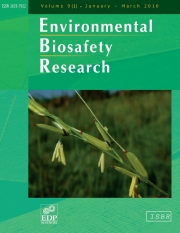Crossref Citations
This article has been cited by the following publications. This list is generated based on data provided by
Crossref.
Yoshimura, Yasuyuki
Beckie, Hugh J.
and
Matsuo, Kazuhito
2006.
Transgenic oilseed rape along transportation routes and port of Vancouver in western Canada.
Environmental Biosafety Research,
Vol. 5,
Issue. 2,
p.
67.
Knispel, Alexis L.
McLachlan, Stéphane M.
Van Acker, Rene C.
and
Friesen, Lyle F.
2008.
Gene Flow and Multiple Herbicide Resistance in Escaped Canola Populations.
Weed Science,
Vol. 56,
Issue. 1,
p.
72.
2008.
Opinion of the Scientific Panel on Genetically Modified Organisms on applications (references EFSA‐GMO‐UK‐2005‐25 and EFSA‐GMO‐RX‐T45) for the placing on the market of the glufosinate‐tolerant genetically modified oilseed rape T45, for food and feed uses, import and processing and for renewal of the authorisation of oilseed rape T45 as existing product, both under Regulation (EC) No 1829/2003 from Bayer CropScience.
EFSA Journal,
Vol. 6,
Issue. 3,
Chandler, Stephen
and
Dunwell, Jim M.
2008.
Gene Flow, Risk Assessment and the Environmental Release of Transgenic Plants.
Critical Reviews in Plant Sciences,
Vol. 27,
Issue. 1,
p.
25.
Taverniers, Isabel
Papazova, Nina
Bertheau, Yves
De Loose, Marc
and
Holst-Jensen, Arne
2008.
Gene stacking in transgenic plants: towards compliance between definitions, terminology, and detection within the EU regulatory framework.
Environmental Biosafety Research,
Vol. 7,
Issue. 4,
p.
197.
Wilkinson, Mike
and
Tepfer, Mark
2009.
Fitness and beyond: Preparing for the arrival of GM crops with ecologically important novel characters.
Environmental Biosafety Research,
Vol. 8,
Issue. 1,
p.
1.
2009.
Request from the European Commission related to the safeguard clause invoked by Austria on oilseed rape MS8, RF3 and MS8×RF3 according to Article 23 of Directive 2001/18/EC.
EFSA Journal,
Vol. 7,
Issue. 6,
Nishizawa, Toru
Nakajima, Nobuyoshi
Aono, Mitsuko
Tamaoki, Masanori
Kubo, Akihiro
and
Saji, Hikaru
2009.
Monitoring the occurrence of genetically modified oilseed rape growing along a Japanese roadside: 3-year observations.
Environmental Biosafety Research,
Vol. 8,
Issue. 1,
p.
33.
2009.
Request from the European Commission related to the safeguard clause invoked by Austria on oilseed rape GT73 according to Article 23 of Directive 2001/18/EC.
EFSA Journal,
Vol. 7,
Issue. 6,
Holst-Jensen, Arne
2009.
Testing for genetically modified organisms (GMOs): Past, present and future perspectives.
Biotechnology Advances,
Vol. 27,
Issue. 6,
p.
1071.
Knispel, Alexis L.
and
McLachlan, Stéphane M.
2010.
Landscape-scale distribution and persistence of genetically modified oilseed rape (Brassica napus) in Manitoba, Canada.
Environmental Science and Pollution Research,
Vol. 17,
Issue. 1,
p.
13.
Song, Xiaoling
Wang, Zhou
Zuo, Jiao
Huangfu, Chaohe
and
Qiang, Sheng
2010.
Potential gene flow of two herbicide-tolerant transgenes from oilseed rape to wild B. juncea var. gracilis.
Theoretical and Applied Genetics,
Vol. 120,
Issue. 8,
p.
1501.
Snow, A. A.
Culley, T. M.
Campbell, L. G.
Sweeney, P. M.
Hegde, S. G.
and
Ellstrand, N. C.
2010.
Long‐term persistence of crop alleles in weedy populations of wild radish (Raphanus raphanistrum).
New Phytologist,
Vol. 186,
Issue. 2,
p.
537.
Moon, Hong S.
Abercrombie, Laura L.
Eda, Shigetoshi
Blanvillain, Robert
Thomson, James G.
Ow, David W.
and
Stewart, C. N.
2011.
Transgene excision in pollen using a codon optimized serine resolvase CinH-RS2 site-specific recombination system.
Plant Molecular Biology,
Vol. 75,
Issue. 6,
p.
621.
Schafer, Meredith G.
Ross, Andrew A.
Londo, Jason P.
Burdick, Connie A.
Lee, E. Henry
Travers, Steven E.
Van de Water, Peter K.
Sagers, Cynthia L.
and
Herrera-Estrella, Alfredo
2011.
The Establishment of Genetically Engineered Canola Populations in the U.S..
PLoS ONE,
Vol. 6,
Issue. 10,
p.
e25736.
MIZUGUTI, Aki
YOSHIMURA, Yasuyuki
SHIBAIKE, Hiroyuki
and
MATSUO, Kazuhito
2011.
Persistence of Feral Populations of Brassica napus Originated from Spilled Seeds around the Kashima Seaport in Japan.
Japan Agricultural Research Quarterly: JARQ,
Vol. 45,
Issue. 2,
p.
181.
Watrud, Lidia S.
King, George
Londo, Jason P.
Colasanti, Ricardo
Smith, Bonnie M.
Waschmann, Ronald S.
and
Lee, E. Henry
2011.
Changes in constructedBrassicacommunities treated with glyphosate drift.
Ecological Applications,
Vol. 21,
Issue. 2,
p.
525.
Lu, Bao‐Rong
and
Wang, Wei
2012.
Plant Gene Containment.
p.
1.
2012.
Scientific Opinion on application (EFSA-GMO-BE-2010-81) for the placing on the market of genetically modified herbicide-tolerant oilseed rape Ms8, Rf3 and Ms8 × Rf3 for food containing or consisting of, and food produced from or containing ingredients pro.
EFSA Journal,
Vol. 10,
Issue. 9,
p.
2875.
2012.
Scientific Opinion on a request from the European Commission related to the prolongation of prohibition of the placing on the market of genetically modified oilseed rape event GT73 for import, processing and feed uses in Austria.
EFSA Journal,
Vol. 10,
Issue. 9,
p.
2876.


